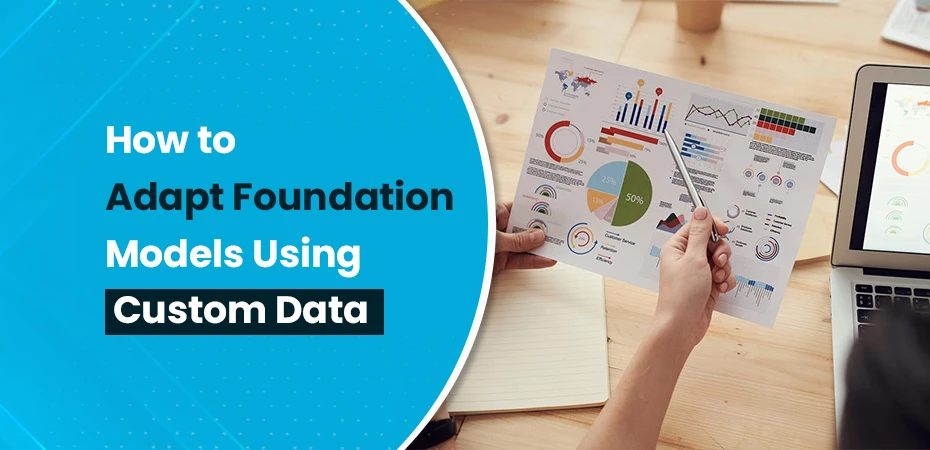How to Adapt Foundation Models Using Custom Data



Have you ever wondered how tech companies create AI models that fit your business needs? The key is adapting foundation models with your own data.
Foundation models are AI systems that are pre-trained on general knowledge. They are like students who know the basics but need more training for specific tasks. Models like GPT-4 or BERT already have broad capabilities but can be customized for your business.
Why adapt these models with your data? Here’s why:
- Better Performance: Custom data helps models understand the language and context of your industry.
- Competitive Advantage: Tailored models give more accurate and relevant results for your needs.
- Cost-Effective: Using existing models saves time and resources compared to building one from scratch.
In this guide, we’ll show you how to adapt foundation models. You’ll learn the steps, tools, and best practices to make these foundational AI systems work perfectly for your business goals.
Understanding Foundation Models
AI Foundation models are a major breakthrough in artificial intelligence. They are large neural networks trained on huge amounts of data, forming the basis for many AI applications. These models can analyze and comprehend patterns in various types of data, including text, images, code, and audio.
Key Players in the Foundation Model Landscape:
GPT-4
Large language models are a subset of foundation models. OpenAI’s latest foundation (LLM) large language model shows impressive abilities in understanding natural language, solving complex problems, generating code, and creating creative writing.
DALL-E 2
This specialized model is great at generating images from text descriptions, transferring styles, manipulating visual concepts, and creating artwork.
BERT
Google’s BERT is designed for natural language processing (NLP), analyzing text with context, answering questions, and classifying documents.
These foundation models (AI) examples are strong because they use transformer architecture, a powerful design for neural networks. This design processes data with multiple attention layers. It lets the models analyze data at once, find connections over long distances, and understand context in large datasets. It also works well with more data and parameters.
These models do well because of self-attention. This means each part of the data can interact with every other part. This creates a deep understanding of context and helps generate human-like results in many areas.
Adapting Foundation Models
Adapting foundation technology models can be done in two main ways: fine-tuning and continued pre-training. Let’s look at these methods.
Fine-Tuning vs. Continued Pre-Training
- Fine-Tuning: Focuses on specific tasks using labeled datasets.
- Continued Pre-Training: Expands the model’s knowledge using unlabeled data.
Both methods can be used together for better results.
Fine-Tuning Process
- Prepare a labeled dataset for your task.
- Choose the right learning rate and batch size.
- Start the model with pre-trained weights.
- Train the model on your custom dataset and track validation metrics.
- Check the model’s performance on a test set.
Benefits of Continued Pre-Training
- Reduces the need for costly labeled data.
- Adds knowledge about specific areas.
- Improves performance on specific tasks.
- Keeps the model’s general skills while gaining new expertise.
Practical Tips
- Start with small learning rates to avoid losing important knowledge.
- Use gradient checkpointing to save memory.
- Stop early to prevent the model from overfitting.
- Track the training loss to improve performance.
Choosing between these methods depends on your available data, resources, and needs. If you have lots of unlabeled data, continued pre-training might be best. If you have fewer but high-quality labeled datasets, fine-tuning could be more effective.
Data-Centric Approaches to Model Adaptation
High-quality data is the foundation framework of successful adaptation of foundation models. A well-curated dataset can significantly impact model performance, reducing training time and improving accuracy.
Key Elements of Quality Data:
- Accurate labels and annotations
- Balanced representation across categories
- Diverse examples covering edge cases
- Clean, noise-free samples
- Consistent formatting and structure
Creating Effective Datasets
To create effective datasets, you need to plan carefully and think about your specific goals. Here’s a simple approach to designing a good dataset.
Define Clear Objectives
Start by identifying what tasks you want to accomplish and what outcomes you expect. Set clear performance measures to track success. Make sure you have high-quality data standards in place.
Data Collection Strategies
You can gather data from internal company databases, industry-specific sources, or public datasets that are trustworthy. You may also create synthetic data when needed.
Recommended Data Sources:
- Academic Repositories: ArXiv, Papers with Code
- Government Databases: Data.gov, Eurostat
- Industry Platforms: Kaggle, Google Dataset Search
- Specialized Collections: ImageNet, MNIST
Data validation and preprocessing are crucial for maintaining dataset quality. Implementing robust validation pipelines helps identify inconsistencies, missing values, and potential biases before model training begins.
Best Practices for Data Preparation:
- Regular data audits
- Automated quality checks
- Documentation of data lineage
- Version control for datasets
- Standardized preprocessing steps
Tools and Platforms for Customization
The AI industry offers robust platforms designed to streamline foundation model adaptation. Let’s explore the leading platforms and their unique features:
1. IBM Watsonx
IBM Watsonx offers several features that make it a powerful tool for customizing AI models:
- Built-in prompt engineering interface
- Automated model evaluation tools
- Specialized data preparation utilities
- Support for both code and no-code implementations
2. Amazon SageMaker
Amazon SageMaker comes with a range of features that enhance the customization process:
- Integrated labeling workflows
- Built-in experiment tracking
- Automated hyperparameter optimization
- Pre-built containers for popular ML frameworks
3. Google Cloud Vertex AI
With Google Cloud Vertex AI, you can take advantage of its unique features for model customization:
- Custom model training pipelines
- AutoML capabilities
- Feature store for data management
- MLOps tooling for deployment
4. Microsoft Azure AI
Microsoft Azure AI provides various features that simplify the customization of AI models:
- Drag-and-drop model customization
- Automated data validation
- Integrated testing environments
- Enterprise-grade security controls
These platforms offer unique features for labeling data automatically. They also have systems for ensuring data quality and verifying labels. Some platforms allow multiple people to collaborate on labeling.
For prompt engineering, these platforms offer libraries with templates, version control for prompts, and tools for A/B testing. They also provide performance analytics to track results.
Each platform has its strengths. SageMaker is great for scaling. Watsonx focuses on integrating with enterprises. Vertex AI is good for AutoML, and Azure AI is easy for developers new to AI.
Challenges in Adapting Foundation Models
Adapting foundation (AI) models presents several critical challenges that organizations need to navigate carefully. Let’s explore the key obstacles and their solutions:
1. Data Privacy and Compliance
- Handling sensitive customer information within regulatory frameworks
- Meeting GDPR, HIPAA, and industry-specific compliance requirements
- Implementing robust data anonymization techniques
- Creating audit trails for model training processes
2. Cost Considerations
- High computational resources required for model training
- Expensive GPU infrastructure investments
- Storage costs for large datasets
- Ongoing maintenance and monitoring expenses
3. Technical Complexities
- Limited expertise in fine-tuning (LLM) foundation models
- Risk of catastrophic forgetting during adaptation
- Balancing model performance with resource constraints
- Managing version control across multiple model iterations
4. Governance Framework Solutions
- Implement role-based access controls
- Create clear documentation of model training procedures
- Establish model validation protocols
- Set up regular model performance reviews
5. Quality Assurance Strategies
- Regular bias testing and mitigation
- Continuous monitoring of model outputs
- Performance benchmarking against baseline models
- Systematic error analysis and correction
Organizations can address these challenges by adopting a structured approach to model adaptation. This includes setting up dedicated teams for compliance monitoring, investing in scalable infrastructure, and developing comprehensive governance frameworks that align with business objectives while maintaining model integrity.
Exploring Future Trends in Foundation Model Adaptation
The world of foundation model adaptation is changing quickly, with new technologies reshaping how we customize AI models. Let’s take a look at the exciting developments that are on the way:
1. Integration of GANs in Model Adaptation
- Generative Adversarial Networks (GANs) are changing the way models learn from custom data
- GANs allow foundation models to create synthetic training data, reducing reliance on large labeled datasets
- The combination of GANs and foundation models leads to more flexible and adaptable systems
2. AGI-Inspired Adaptation Techniques
- Concepts from Artificial General Intelligence (AGI) are influencing how foundation models understand and adjust to new information
- Multi-modal learning abilities enable models to comprehend and produce content in various formats
- Self-learning methods allow models to constantly enhance their performance with little human involvement
3. Emerging Customization Approaches
- Zero-shot and few-shot learning techniques lessen the need for extensive training data
- Neural architecture search automates the process of finding optimal model configurations
- Hybrid approaches combine different adaptation methods for improved performance
4. Industry-Specific Innovations
- Modifications in architecture specific to certain industries
- Automated feature engineering systems that adapt to changing data patterns
- Real-time adaptation abilities that respond to shifting user needs
The combination of these technologies with foundation models suggests a future where AI systems become more self-sufficient and effective at learning from custom data, while still being highly accurate and dependable.
Conclusion
Adapting foundation models with custom data is a game changer for businesses looking to gain an edge over their competitors. However, this process is complex and requires specialized knowledge and careful consideration of various technical factors.
To get the most out of their AI investments, organizations should partner with skilled professionals who understand both the technical details and business implications of model adaptation.
Expert guidance can be invaluable in choosing the right foundation models, creating effective data collection strategies, implementing strong fine-tuning processes, and making sure regulatory requirements are met.
For businesses wanting to implement custom AI solutions, our team of experienced professionals specializes in adapting foundation models to specific industry needs. We combine technical expertise with practical business understanding to deliver tailored AI solutions that drive real results.
Ready to transform your business with custom AI solutions? Phoenix Ninja offers comprehensive support for foundation model adaptation projects.
Frequently Asked Questions (FAQs)
The adaptation time varies based on dataset size and complexity, ranging from a few hours to several weeks.
Quality matters more than quantity. Start with 100-1000 high-quality examples for basic fine-tuning.
Yes, platforms like IBM Watsonx and Amazon SageMaker support parallel model adaptation.
While GPUs accelerate the process, many cloud platforms offer ready-to-use infrastructure.
Implement regular monitoring, bias testing, and documentation of training data and processes.